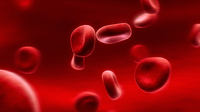The Perfection of Red Blood Cells
By Billie Rubin, Hemoglobin’s Catabolic Cousin, reporting from the labs of Stanford Blood Center
Red Blood Cells (RBCs) have some particularly unusual characteristics for a cell. For one, they have a biconcave shape, giving both sides a “scooped-in” appearance.
They also lack a nucleus when fully mature. These traits help them do the job they do. Without a nucleus they have more space to carry the gases they transport (oxygen and carbon dioxide). They also have less mass. If RBCs had a nucleus, blood would have more mass and the heart would have to work 20% harder.
In addition, the RBC’s biconcave shape gives them more flexibility to squeeze into small capillaries (which are only slightly larger than the RBC itself) and a maximum surface area to facilitate the transfer of the gases they carry. They are the picture of perfection for just what they do.

